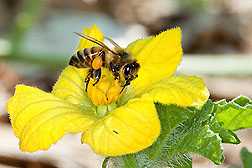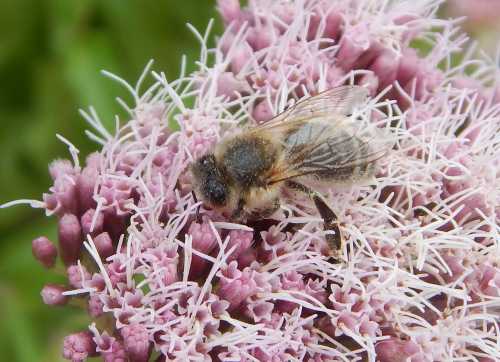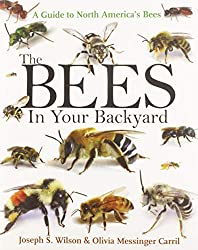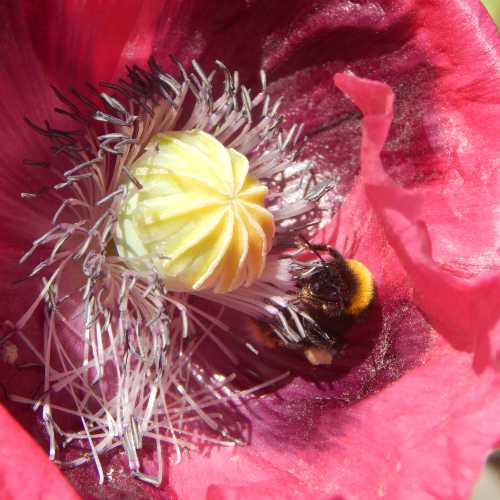Do Bees Pollinate Watermelons?
Can We Grow Watermelons Without Bees?
Question:
Are bees needed to pollinate watermelons?
The short answer is:
Yes, bees are vital for pollinating watermelons not only for the plant to be able to produce an abundance of fruit, but also to ensure that the watermelons are healthy, and with a good shape. Pollination by bees also affects the sweetness of the fruit.
If you found this page helpful or interesting, I'd really be grateful if you would share it with others - if not this page, perhaps another, such as Gardening For Bees.
Thank you so much :) .
3 Reasons why watermelons need bees to pollinate the flowers
Firstly, it should be mentioned that cross pollination by insects is essential for growing watermelons. Although research has demonstrated the contribution of various flies and wasps, bees are by far the most important and efficient pollinator.
- According to The University of California (David) Vegetable Research And Information Centre, inadequate pollination by bees may result in both poor fruit set, and misshapen fruit1.
- According to the University of Delaware, inadequate pollination by bees may result not only in misshapen fruit and fewer fruits per plant, but also hollow heart, which can be seen as an internal split or divide in the middle of the fruit, resulting in a gap in the center2.
- Pollination by bees may be at least partly be linked to the sweetness in watermelons (although contrary to old wives' tales, there's no evidence of bees stinging watermelons). The University of Delaware state that following successful pollination by bees ultimately the fruit expands as sugar accumulates2.
(Similarly, bee pollination has been linked to sweetness in apples).
 A honey bee worker foraging on a watermelon flower.
A honey bee worker foraging on a watermelon flower.Source: U.S. Department of Agriculture.
3 Facts about pollination and watermelons
- Watermelon flowers are only open for one day, and it is therefore vital the flower is visited by bees on that day so that the opportunity for pollination (and the growing of the fruit) is not missed! This means plenty of bees are needed for pollinating a field of watermelons.
- Flowers open in the early morning hours and close in
the afternoon and do not reopen even if they are not
pollinated3.
- Research suggest that flowers of standard seeded watermelons need to be visited by bees seven or eight times for adequate fertilization4,5.
Which bees pollinate watermelons?
Mostly honey bees but also sweat bees and base-banded furrow bees, but how do we know?
This question has been investigated by scientists.
In 2019, researchers published a scientific paper which examined 40 commercial watermelon fields from 2013 to 2016, and obtained information on pollinator visitation rates for managed and wild pollinators at different distances from field margins3. The scientists determined the amount of collected pollen on the pollinators’ bodies, how much time the pollinators spent on flowers, and the amount of pollen they deposited on stigmas.
They found that:
- Managed honey bees Apis mellifera L were the most common visitor (comprising 47% of flower visits), along with 31 other bees species also visited the fields.
- Notably the green sweat bee, Agapostemon splendens Lepeletier were abundant (accounting for 25.7% of visits) and carried as much pollen as an Apis mellifera worker (as did the scollid wasp Campsomeris plumipes var. fossulana Fabricius).
- Around the field margins, Lasioglossum (base-banded furrow bees) were found in abundance. Lasioglossum pectorale Smith and Lasioglossum puteulanum Gibbs
(21% and 16% of all flower visiting insect catches,
respectively).
- Honey bees visited an average of 10 watermelon flowers per minute, spending an average of 4.5 s per flower, making them efficient pollinators of watermelon flowers.
- The research found that wild and managed bumble bees were not common visitors, and the scientists suggest that bumble bees would not be able to replace honey bees for pollination of watermelons. Overall honey bees and small dark bees were observed visiting watermelon flowers 16 times and 15 times more, respectively, compared to bumble bees (which included managed bumble bees).
The crops were also visited by 5 wasp species and 6 fly species.
The researchers recommended that growers could adopt practices to encourage more wild pollinators to assist with pollination by honey bees.
Are watermelons fruit or vegetables?
Interestingly, although many of us commonly think of, and refer to watermelons as being fruit, it seems they could be either. The watermelon Citrullus lanatus, belongs to the gourd (cucurbitaceae) family of plants, and to a plant order which includes pumpkins and melons (Cucurbitaceae). In the west, it is most commonly used as a sweet fruit, but in China, for example, the outer rind is used as a vegetable, and is pickled in Russia and southern USA.
Source: The National Watermelon Promotion Board, USA.
References
1. https://vric.ucdavis.edu/pdf/MELON/watermelon.pdf
2. Johnson, G. 2014. Watermelon pollination, fruit set, and hollow heart. Weekly crop update. University of Delaware. https://extension.udel.edu/weeklycropupdate/?p=6579
3. Joshua W. Campbell, Cory Stanley-Stahr, Mary Bammer, Jaret C. Daniels & James D. Ellis (2019) Contribution of bees and other pollinators to watermelon (Citrullus lanatus Thunb.) pollination, Journal of Apicultural Research, 58:4, 597-603, DOI: 10.1080/00218839.2019.1614271
4. University of Georgia, Entomology: UGA honey bee program. http://www.ent.uga.edu/bees/beekeeping.html
5. Boyhan, G. E., Granberry, D. M., and Kelley W. T. 2000. Commercial watermelon production. Bulletin 996. UGA Cooperative Extension Service.



